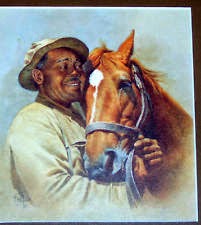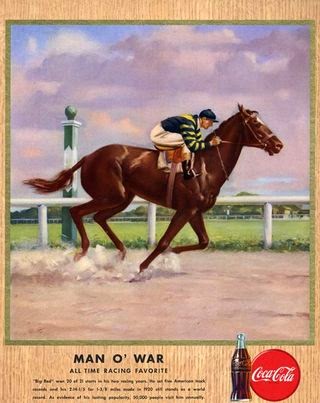If the millions and millions of fans around the world think they have it bad trying to pick the winner of the Derby and then sweating out the fastest two minutes in sports as the horses pound around the track tomorrow, just think what the horses went through to get on the track.
They are the result of generations of breeding and bloodlines. Of the two greatest horses in thoroughbred racing history, Lexington, Kentucky bred Man o' War set the standard for all time to come.
The other greatest thoroughbred of all time was Secretariat (March 30, 1970 - October 4, 1989), an American Thoroughbred racehorse that in 1973 became the first U.S. Triple Crown winner in 25 years. He set records in all three events in the series - the Kentucky Derby (1:59 2/5), the Preakness Stakes (1:53), and the Belmont Stakes (2:24) - records that still stand today, 41 years later.
He is considered to be one of the greatest Thoroughbreds of all time. In 1999, ESPN ranked Secretariat the 35th best athlete of the 20th century, the highest ranking racehorse on the list. He ranked second behind Man o' Was in The Blood-Horse's List of the Top 100 U.S. Racehorses of the 20th Century.
But a lot less is known about Man o' War, the greatest Kentucky horse to never run in the Kentucky Derby, so here is his story.
Man o' War came close to perfection
By Larry Schwartz
Special to ESPN
When thoroughbred racing needed a boost, Man o' War unleashed his blazing speed and came to the rescue. Though he competed for only two years, he energized a reeling sport.
Let's look at the world of racing that Man o' War entered in 1919: Racing in New York had been eliminated in 1911 and 1912 because of anti-gambling legislation led by Gov. Charles Hughes. Other states had taken up Hughes' crusade. Many stables had folded and some of the bigger ones had moved to Europe.
While racing was legalized again in 1913, World War I soon dominated the public's attention. Attendance and pursues were at record lows when Man o' War made his debut on June 6, 1919.
By the time he retired 16 months later, he was a national hero, joining Babe Ruth as the first shining stars of the Roaring Twenties. The charismatic horse's popularity had brought fans back to the race track.
Man o' War went to the post 21 times and won 20 races. He won one race by an incredible 100 lengths and triumphed in another carrying 138 pounds. He whipped a Triple Crown champion by seven lengths in a match race.
He brought international recognition to Kentucky breeders and made the United States the racing center of the world. When he retired, he held five American records at different distances and had earned more money than any thoroughbred.
In a mid-century Associated Press poll, he was overwhelmingly voted the greatest thoroughbred of the first half of the 20th century.
Not only did Man o' War perform like a superstar on the track, the chestnut-colored horse (though he was nicknamed "Big Red") looked like one. At 3, he was a strapping 16.2 hands (about 5-foot-6) and weighed about 1,125 pounds with a 72-inch girth. His appetite also was huge, as he ate 12 quarts of oats every day, or about three quarts more than the average racehorse. He ran in big bounds as well, with his stride measuring an incredible 25 to 28 feet.
Bred by August Belmont II, son of the founder of Belmont Park and for whom the Belmont Stakes was named, the future champion was foaled on March 29, 1917 at Nursery Stud near Lexington, Ky. His sire was Fair Play and his dam was Mahubah, the daughter of Rock Sand, the 1903 winner of Britain's version of the Triple Crown (the 2,000 Guineas, the Epsom Derby and the St. Leger). He was 15 generations removed from the Godolphin Arabia, one of three Arab and Barb stallions considered to be the founders of the thoroughbred line.
Originally, Belmont's wife named the horse My Man o' War, after her soldiering husband, who was stationed in France during World War I, but the "My" was later dropped.
Belmont's military involvement prompted him to sell his entire 1917 yearling crop. Sportsman Samuel Riddle, owner of the Glen Riddle Farm, was the beneficiary of this decision. Accepting the judgment of trainer Louis Feustel, Riddle purchased the rangy colt, who seemed too large for a yearling, for $5,000 at the Saratoga yearlings' sales. "As soon as I saw him, he simply bowled me over," Riddle said.
At the beginning, Man o' War's aversion to the bridle and saddle caused problems. "He's nice and he's smart, but don't ever try to force him or you'll come out second best every time," a stable boy said. "Ask him and he'll do what you want. Push him and it's all off."
Under Feustel's training, patience paid off, and the energy of Man o' War was harnessed. His debut, in a five-furlough maiden race against six other 2-year-olds at Belmont, was no contest. The fans reportedly screamed and pounded the rail as jockey Johnny Loftus tightened the reins at the stretch, slowing Man o' War to a virtual canter. But the horse still won by six lengths.

"He made half-a-dozen high-class youngsters look like $200 horses," wrote the turf editor of the New York Morning Telegraph.
Following his smashing debut, Man o' War won three stakes races, at three different New York tracks, in the next 17 days.
His winning streak was at six when Man o' War raced in the Sanford Stakes at Saratoga on Aug. 13. It is Man O' War's most remembered race -- because it is the only one he would lose.
Starting gates were not yet used, and horses were led up a tape barrier. A fill-in starter had difficulty getting the horses ready and they milled around. While Man o' War apparently was backing up, the tape was sprung. Man o' War "was almost left at the post," the Louisville Courier-Journal reported.
After a slow start, Man o' War was third as the field headed for home in the six-furlough race. Blocked by close quarters, he had to go to the outside in the final eighth. Though he gamely made up ground, he missed by a half-length of overtaking the winner, who at 115 pounds carried 15 fewer pounds than the 11-20 favorite. The winner was named, rather appropriately, Upset.
Big Red, who beat Upset in their six other meetings, finished the year with easy victories in the Hopeful and Futurity, giving him nine victories in 10 races.
In 1920, Man o' War won all 11 of his races, with Clarence Kummer aboard nine times. Big Red didn't race in the Kentucky Derby because Riddle believed that a soft-boned 3-year-old should not have to run 1¼ miles in early May. Instead, he set his sights on the Preakness (Man o' War held off an Upset charge to win) and Belmont (a 20-length victory in a two-horse field).
After winning the Travers against two horses at Saratoga, only one colt challenged Man o' War in his next race. Well, it wasn't exactly a challenge as Big Red, the 1-100 favorite, defeated Hoodwink by 100 lengths in the 1 5/8th-mile Lawrence Realization at BelmontPark.
He was 1-100 again in winning the Jockey Cup at Belmont Park, and then he was saddled with the excessively high weight of 138 pounds for the Potomac Handicap. After being a bit fractious at the post, he assumed command and won easily.
Man o' War's last race was against Sir Barton, who in 1919 had become the first to win the Kentucky Derby, Preakness and Belmont. Like most match races, it was hardly competitive. At Kenilworth Park, in Windsor, Ontario, Man o' War won the $75,000 purse and $5,000 Gold Cup by defeating the older Canadian-owned horse by seven lengths.
When Riddle was informed that Man o' War would have to carry even more than 138 pounds as a 4-year-old, he retired his horse to stud. Man o' War held American records for the fastest mile, 1 1/8 miles, 1 3/8 miles, 1½ miles and 1 5/8 miles. His total earnings were $249,465, a record at the time.

Don't feel sorry for Man o' War because he stopped racing so young. He proved to be quite a stud. In 1926, his issue won $408,137, breaking a 60-year-old record.
Following his undefeated season of 11 straight wins, Man o' War traveled to Lexington, Kentucky, to enter at stud at Elizabeth Daingerfield's Haylands and later moved to Riddle's Faraway Farm. Man o' War was a top sire who produced more than 64 stakes winners and various champions. Though many believe that Riddle did not breed the stallion to enough good mares after the first five seasons, he still sired many leading horses.
Man o' War sired American Flag and Crusader, who won successive Belmont Stakes in 1925 and 1926. Although there were no official champions in America at the time, both colts were generally considered the best three-year-old colts of their year, and Crusader was also largely accepted as the best racehorse of 1926.
Among Man o' War's other famous offspring were 1929 Kentucky Derby winner Clyde Van Dusen, Battleship (who won the 1938 English Grand National steeplechase), and War Admiral, the 1937 Triple Crown winner and the second official Horse of the Year. Another of his offspring, Hard Tack, sired Seabiscuit, who was Horse of the Year in 1938. Man o' War's most successful sons at stud were War Admiral and War Relic, and War Relic's branch of the male line survives today.
Tiznow, Honor and Glory, and Bertrando are also all sire-line descendants of Man o' War. According to Kent Hollingsworth, 37 per cent of all stakes winners in 1966 were descendants of Man o' War. Despite not covering more than 25 mares in any season, Man o' War sired 379 named foals during 22 seasons at stud. His daughters kept Man o' War listed in the 10 leading broodmare sires list for 22 years.
In 1921, a Texas oil millionaire, William Waggoner, offered $500,000 for Man o' War. Riddle turned him down, as he did when Waggoner increased his offer again, first to $1 million and then a blank check. "The colt is not for sale," he said.
Although Man o' War spent most of his life in Kentucky, he never raced there. He died there, though, at the age of 30 of a heart attack on Nov. 1, 1947 in Lexington.
.

































